Related Research Articles
The United States Armed Forces are the military forces of the United States. The armed forces consists of six service branches: the Army, Marine Corps, Navy, Air Force, Space Force, and Coast Guard. All six armed services are among the eight uniformed services of the United States.

The National Security Act of 1947 was a law enacting major restructuring of the United States government's military and intelligence agencies following World War II. The majority of the provisions of the act took effect on September 18, 1947, the day after the Senate confirmed James Forrestal as the first secretary of defense.
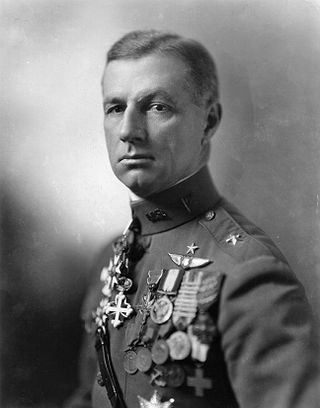
William Lendrum Mitchell was a United States Army officer who is regarded as the father of the United States Air Force.

Raynal Cawthorne Bolling was the first high-ranking officer of the United States Army to be killed in combat in World War I. A corporate lawyer by vocation, he became an early Army aviator and the organizer of both of the first units in what ultimately became the Air National Guard and the Air Force Reserve Command.
This is a list of aviation-related events from 1947:
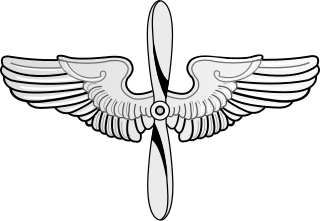
The United States Army Air Service (USAAS) was the aerial warfare service component of the United States Army between 1918 and 1926 and a forerunner of the United States Air Force. It was established as an independent but temporary branch of the U.S. War Department during World War I by two executive orders of President Woodrow Wilson: on May 24, 1918, replacing the Aviation Section, Signal Corps as the nation's air force; and March 19, 1919, establishing a military Director of Air Service to control all aviation activities. Its life was extended for another year in July 1919, during which time Congress passed the legislation necessary to make it a permanent establishment. The National Defense Act of 1920 assigned the Air Service the status of "combatant arm of the line" of the United States Army with a major general in command.
The Bureau of Aeronautics (BuAer) was the U.S. Navy's material-support organization for naval aviation from 1921 to 1959. The bureau had "cognizance" (i.e., responsibility) for the design, procurement, and support of naval aircraft and related systems. Aerial weapons, however, were under the cognizance of the Navy's Bureau of Ordnance (BuOrd).
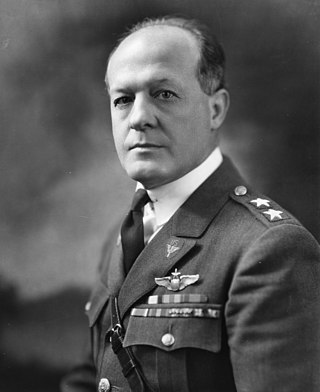
Benjamin Delahauf Foulois was a United States Army general who learned to fly the first military planes purchased from the Wright brothers. He became the first military aviator as an airship pilot, and achieved numerous other military aviation "firsts". He led strategic development of the Air Force in the United States.
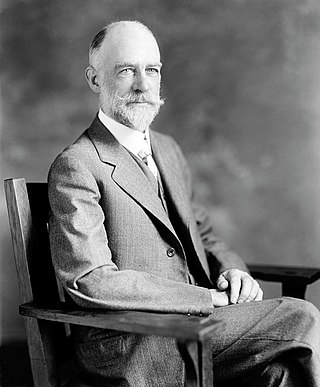
William Frederick Durand was a United States naval officer and pioneer mechanical engineer. He contributed significantly to the development of aircraft propellers. He was the first civilian chair of the National Advisory Committee for Aeronautics, the forerunner of NASA.

The Aeronautical Division, Signal Corps (1907–1914) was the first heavier-than-air military aviation organization in history and the progenitor of the United States Air Force. A component of the U.S. Army Signal Corps, the Aeronautical Division procured the first powered military aircraft in 1909, created schools to train its aviators, and initiated a rating system for pilot qualifications. It organized and deployed the first permanent American aviation unit, the 1st Aero Squadron, in 1913. The Aeronautical Division trained 51 officers and 2 enlisted men as pilots, and incurred 13 fatalities in air crashes. During this period, the Aeronautical Division had 29 factory-built aircraft in its inventory, built a 30th from spare parts, and leased a civilian airplane for a short period in 1911.

The Aviation Section, Signal Corps, was the aerial warfare service of the United States from 1914 to 1918, and a direct statutory ancestor of the United States Air Force. It absorbed and replaced the Aeronautical Division, Signal Corps, and conducted the activities of Army aviation until its statutory responsibilities were suspended by President Woodrow Wilson in 1918. The Aviation Section organized the first squadrons of the aviation arm and conducted the first military operations by United States aviation on foreign soil.
The Division of Military Aeronautics was the name of the aviation organization of the United States Army for a four-day period during World War I. It was created by a reorganization by the War Department of the Aviation Section, U.S. Signal Corps on April 24, 1918, still as part of the Signal Corps. It was removed from the Aviation Section by executive order on May 20, 1918, and existed as the sole Army aviation agency until a War Department general order issued May 24, 1918, established it and the Bureau of Aircraft Production, created by the same reorganization on April 24, as coordinate components of the "Air Service". As such, it is recognized by the United States Air Force as the third of its antecedents.

Frank Purdy Lahm was an American aviation pioneer, the "nation's first military aviator", and a general officer in the United States Army Air Corps and Army Air Forces.
The United States Air Force became a separate military service on 18 September 1947 with the implementation of the National Security Act of 1947. The Act created the National Military Establishment, later renamed the United States Department of Defense, which was composed of four of the five branches, the Army, Marine Corps, Navy, and a newly created Air Force. Prior to 1947, the responsibility for military aviation was divided between the Army for land-based operations and the Navy and Marine Corps for sea-based operations from aircraft carrier and amphibious aircraft. The Army created the first antecedent of the Air Force on 1 August 1907, which through a succession of changes of organization, titles, and missions advanced toward eventual separation 40 years later. The predecessor organizations leading up to today's U.S. Air Force are:

The United States Marine Corps Aviation (USMCA) is the aircraft arm of the United States Marine Corps. Aviation units within the Marine Corps are assigned to support the Marine Air-Ground Task Force, as the aviation combat element, by providing six functions: assault support, antiair warfare, close air support, electronic warfare, control of aircraft and missiles, and aerial reconnaissance. The Corps operates rotary-wing, tiltrotor, and fixed-wing aircraft mainly to provide transport and close air support to its ground forces. Other aircraft types are also used in a variety of support and special-purpose roles. All Marine Corps aviation falls under the influence of the Deputy Commandant for Aviation, whose job is to advise the Commandant of the Marine Corps in all matters relating to aviation, especially acquisition of new assets, conversions of current aircraft, maintenance, operation, and command.
The United States Marine Corps's Advanced Base Force was a coastal and naval base defense force that was designed to set up mobile and fixed bases in the event of major landing operations within, and beyond, the territorial United States. Established in the beginning of the 20th century, the Advanced Base Force was the United States' first combined task force built on the concept of the Marine Corps' traditional role in expeditionary warfare. The slow development of the advanced base force played a significant role in the controversy over the removal of the ships' guards in 1908–1909.

The United States Army Air Corps (USAAC) was the aerial warfare service component of the United States Army between 1926 and 1941. After World War I, as early aviation became an increasingly important part of modern warfare, a philosophical rift developed between more traditional ground-based army personnel and those who felt that aircraft were being underutilized and that air operations were being stifled for political reasons unrelated to their effectiveness. The USAAC was renamed from the earlier United States Army Air Service on 2 July 1926, and was part of the larger United States Army. The Air Corps became the United States Army Air Forces (USAAF) on 20 June 1941, giving it greater autonomy from the Army's middle-level command structure. During World War II, although not an administrative echelon, the Air Corps (AC) remained as one of the combat arms of the Army until 1947, when it was legally abolished by legislation establishing the Department of the Air Force.
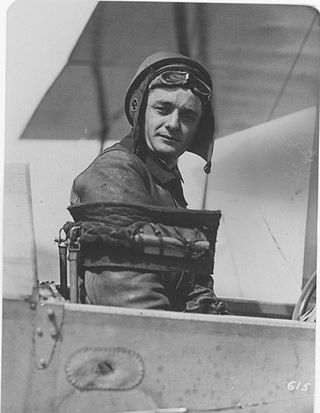
Townsend Foster Dodd was the first commissioned US Army aviator. As a University of Illinois graduate with a Bachelor of Science in electrical engineering, he joined the Coast Artillery Corps and shortly thereafter became an aviator in the US Army Air Service. Dodd sat on many boards of review during the service's infancy and was one of the members who condemned pusher planes in favor of tractors. He served with General John Pershing on the Mexican Border where he set records for endurance flying. During World War I he was first assigned as the aviation officer of the American Expeditionary Force in 1917. He was later replaced by Colonel Billy Mitchell and was reassigned to the Bolling Mission.

The National Air and Space Intelligence Center (NASIC) is the United States Air Force unit for analyzing military intelligence on foreign air and space forces, weapons, and systems. NASIC assessments of aerospace performance characteristics, capabilities, and vulnerabilities are used to shape national security and defense policies and support weapons treaty negotiations and verification. NASIC provides the Defense Intelligence Agency (DIA) with specialized intelligence regarding foreign air and space threats.

George Percival Scriven was the seventh Chief Signal Officer of the United States Army (1913–1917). In this position he commanded the Aeronautical Division (1913–1914),and later the Aviation Section (1914–1917) of U.S. Signal Corps, the forerunner of the United States Air Force.
References
- 1 2 Mooney, Charles C. and Layman, Martha E. (1944). "Organization of Military Aeronautics, 1907-1935 (Congressional and War Department Action)" (PDF). Air Force Historical Study No. 25. AFHRA (USAF). Archived from the original (PDF) on 2010-12-27. Retrieved 14 Dec 2010.
{{cite web}}: CS1 maint: multiple names: authors list (link), pp. 27-29. 40 Stat. 296. - ↑ Anne Cipriano Venzon, Jerold Brown in The United States in the First World War: An Encyclopedia, Routledge, 1999, ISBN 0-8153-3353-6 , pages 153 and 520
- The Great War Society Journal, Volume Five, Number Three.